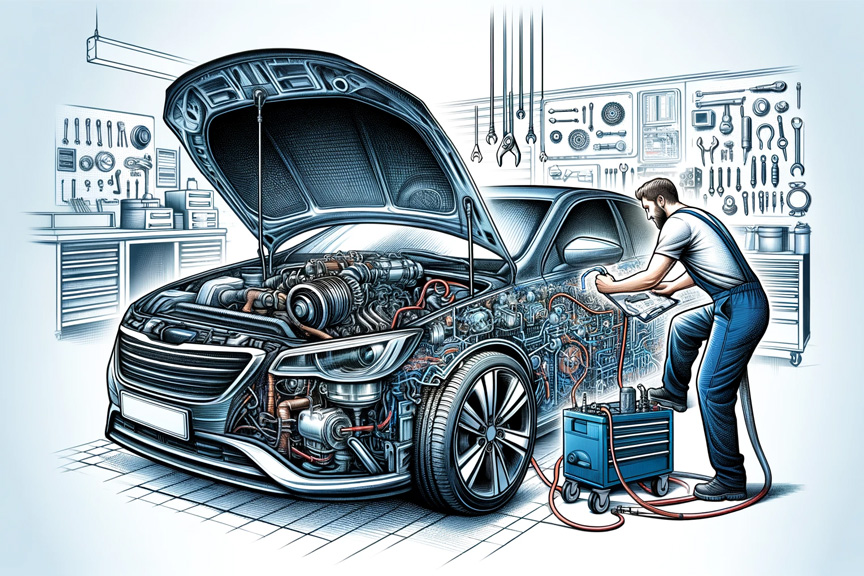
In the height of summer, a car’s air conditioning (AC) is more than a luxury—it’s a necessity. But what happens when your car AC is not working? Understanding the common car AC problems and solutions can save you time and discomfort. This comprehensive guide will walk you through the essential checks and fixes, ensuring you’re covered for those hot days on the road.
The first step in troubleshooting is to identify why your car AC is not working. Several factors can lead to car AC problems, from simple issues like low refrigerant levels to more complex concerns involving engine protection coverage for car.
1. Check the Refrigerant Level: Low refrigerant is a common reason for car AC not cooling effectively. It’s a simple fix that involves refilling the refrigerant, but it’s also essential to check for leaks, as this could lead to a recurrence of the problem.
2. Inspect the Compressor: The AC compressor is crucial for cooling your car. If the compressor is not engaging, it could be due to an electrical fault or a mechanical problem. Regular engine parts coverage can help in the maintenance and repair of such crucial components.
3. Examine the Condenser: The condenser cools the refrigerant after it’s been compressed. Debris or damage to the condenser can impede its function, leading to your car AC not working effectively.
When it comes to engine protection coverage for car, it’s not just about the engine itself. Comprehensive coverage often includes crucial components like the AC system. Engine parts coverage and ac coverage can be a lifesaver, covering the costs of parts and labor associated with AC repairs.
1. Engine Protection Coverage: This usually covers the major components of your car’s engine. While it may not directly cover the AC, ensuring your engine is in top shape indirectly supports the overall performance of your vehicle, including the AC.
2. AC Coverage: Specifically designed to cover repairs and replacements of your car’s AC system, this can be a part of transmission warranty coverage or a standalone option. This coverage is particularly beneficial if you face car ac problems and solutions that involve expensive parts.
While transmission coverage mainly focuses on the transmission system of your car, it’s important to understand how transmission issues can affect your car’s AC. Problems with the transmission can put additional strain on the engine, which in turn can impact the performance of your car’s AC.
1. Transmission Warranty Coverage: This typically covers the cost of repairs for your transmission, which is essential for the smooth functioning of your car. A well-functioning transmission ensures that the engine runs efficiently, indirectly affecting the AC system.
2. Understanding the Link: A struggling transmission can lead to an overworked engine, which may reduce the efficiency of your car’s AC. Therefore, maintaining your transmission with proper transmission warranty coverage is crucial for overall vehicle health.
When your car AC is not working, diagnosing the issue is the first step. Here are some common car ac problems and solutions:
1. Weak Airflow: This could be due to a clogged air filter or issues with the blower. Regular maintenance and checking of these components can prevent such issues.
2. Bad Odor: Sometimes, the AC might emit a foul smell, which could be due to mold or mildew in the system. Cleaning the system can often resolve this issue.
3. No Cold Air: If the AC is blowing air but it’s not cold, it could be due to low refrigerant levels or a faulty compressor.
Regular maintenance is key to preventing car AC problems. Here are some tips:
1. Regular Check-Ups: Schedule regular maintenance check-ups for your car’s AC system. This can help catch issues early and prevent them from escalating.
2. Clean the System: Keeping the AC system clean can prevent issues like bad odors and weak airflow.
3. Engine and Transmission Health: Maintain your engine and transmission’s health with appropriate coverage plans. This indirectly affects the performance of your car’s AC.
When your car AC is not working, it can range from being a minor inconvenience to a significant problem, especially in extreme weather conditions. Understanding what to check and how to fix these issues is essential. Investing in engine protection coverage for car, transmission warranty coverage, and ac coverage can save you from hefty repair bills and ensure your comfort on the road. Regular maintenance and being aware of the common car ac problems and solutions can keep your car’s AC running efficiently, ensuring a cool and comfortable driving experience.
The most common reason for a car’s AC not blowing cold air is a low level of refrigerant, typically due to a leak in the system. Other causes can include a faulty compressor, a clogged condenser, or an issue with the electrical system.
Some car AC problems, like changing a cabin air filter or refilling refrigerant, can be DIY fixes. However, more complex issues, especially those involving the compressor or electrical faults, often require professional diagnosis and repair.
It’s advisable to have your car’s AC system checked by a professional at least once a year. Regular maintenance can help prevent major issues and ensure your AC works efficiently when you need it most.
Signs of a failing AC compressor include strange noises when the AC is turned on, the AC not blowing cold air, or the compressor not engaging. If you suspect your compressor is failing, it’s important to get it checked by a professional to prevent further damage.
The cost of repairing a car’s AC system varies depending on the issue. Simple fixes like refrigerant recharges are relatively inexpensive, but repairs involving the compressor or other major components can be more costly. Regular maintenance can help reduce the likelihood of expensive repairs.
